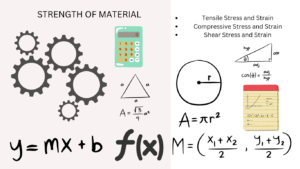Computer-Aided Design (CAD)
Introduction
Computer-Aided Design (CAD) is a technology that revolutionized engineering, architecture, and manufacturing industries. It involves using computer software to design, model, and analyze products with high precision. CAD replaces traditional manual drafting methods, offering efficiency, accuracy, and versatility.
This article explores CAD in detail, covering its history, types, applications, benefits, software tools, and future trends.
Computer-Aided Design (CAD) is a critical and transformative tool in the field of mechanical engineering. It refers to the use of computer software to create, modify, analyze, and optimize designs. CAD plays an essential role in modern product development, mechanical system design, and manufacturing processes. It allows engineers to convert their ideas into precise drawings and 3D models that can be easily edited, shared, and manufactured. Before CAD, engineers relied on manual drafting using paper, pencil, rulers, and compasses, which was time-consuming and prone to error. With the advancement of computer technology, CAD revolutionized the engineering industry by significantly improving productivity, accuracy, and design innovation.
In mechanical engineering, CAD is used for designing mechanical components, assemblies, machines, and tools. It helps engineers visualize complex geometry, understand how different parts fit and function together, and simulate mechanical motion or stress. Mechanical CAD typically involves the creation of 2D drawings and 3D models. 2D CAD is used to generate traditional orthographic views like top, front, and side projections. These drawings are essential for documentation, fabrication, and inspection. 3D CAD, however, is more powerful and widely used today. It allows for the creation of realistic models that can be rotated, zoomed, sectioned, and analyzed for performance even before they are physically made.
There are various types of CAD software used in mechanical engineering, including AutoCAD, SolidWorks, CATIA, Siemens NX, PTC Creo, Autodesk Inventor, and Fusion 360. Each software offers different tools and features tailored for specific industries and applications. For instance, SolidWorks and Inventor are widely used for mechanical part design and product development, while CATIA and Siemens NX are preferred in aerospace and automotive sectors due to their advanced surface modeling and complex assembly capabilities. These platforms support parametric modeling, which means the design is driven by dimensions and constraints, making it easy to modify features and automate repetitive tasks.
The CAD process usually begins with conceptual design, where initial ideas are sketched or modeled. This phase focuses on innovation, brainstorming, and exploring multiple design options. Once a concept is selected, the engineer develops a detailed design that includes dimensions, tolerances, material specifications, and manufacturing details. Assemblies are created by combining individual components and applying constraints such as mates, alignments, or rotations. Engineers can also conduct interference checks, which help detect and resolve collisions or overlapping parts in assemblies. This reduces the chance of errors in manufacturing and improves product quality.
One of the most valuable features of CAD in mechanical engineering is its integration with engineering analysis tools, such as finite element analysis (FEA), computational fluid dynamics (CFD), and motion simulation. FEA allows engineers to evaluate stresses, strains, and displacements in parts and assemblies under various loads and constraints. CFD simulates fluid flow, heat transfer, and pressure distribution across surfaces. Motion simulation analyzes how mechanical linkages move, identifying kinematic and dynamic behavior. These analyses help optimize designs, reduce material costs, and ensure safety and reliability—all before creating physical prototypes.
Another major benefit of CAD is its ability to generate manufacturing data. This includes creating 2D drawings with dimensions and annotations, 3D solid models for CNC machining, and files for 3D printing. CAD software can export data in various file formats like STL, STEP, IGES, and DXF, which are compatible with CAM (Computer-Aided Manufacturing) systems. Integration with CAM allows seamless transfer of design data to machines for automated manufacturing. This digital workflow ensures precision, reduces lead time, and supports the concept of “digital twins”—virtual representations of real-world products.
CAD also plays a crucial role in design for manufacturability (DFM). It allows engineers to assess whether a part can be easily and cost-effectively manufactured using available tools and processes. Design rules can be applied to check minimum wall thickness, hole sizes, draft angles, and tolerance fits. This ensures the design is practical and avoids costly redesigns during production. With CAD, engineers can simulate how a product will be assembled and serviced, identifying potential issues early in the design phase.
In collaborative environments, CAD enhances team communication and project management. Engineers, designers, and manufacturers can share CAD models across departments or locations. Cloud-based CAD platforms allow real-time collaboration, version control, and design reviews. This promotes transparency, faster decision-making, and better integration between design and production teams. For large projects involving multiple stakeholders, CAD files can be linked with PLM (Product Lifecycle Management) systems to manage revisions, approvals, and documentation.
Another application of CAD in mechanical engineering is reverse engineering. Using 3D scanners and measurement devices, engineers can capture the geometry of existing physical parts and recreate their models in CAD. This is useful when updating old components, reproducing legacy parts, or improving competitor designs. The resulting digital models can be modified, analyzed, and manufactured with modern techniques. Reverse engineering, combined with CAD, speeds up innovation and saves significant time in product development.
CAD is also vital in the era of Industry 4.0, where smart manufacturing, automation, and digital transformation are reshaping industries. CAD software is now integrated with artificial intelligence (AI), machine learning, and generative design algorithms that automatically suggest optimal shapes, structures, or configurations based on input criteria. This helps in developing lightweight, cost-efficient, and high-performance designs that may not be intuitive to human designers. Moreover, as additive manufacturing (3D printing) becomes more common, CAD models serve as the digital source for printing complex geometries that are difficult or impossible to machine traditionally.
Mechanical engineers also use CAD to design fixtures, jigs, molds, dies, and tooling essential in manufacturing processes. These tools must be accurate and durable, and CAD helps in visualizing how they will perform during repetitive operations. Sheet metal design, piping systems, HVAC layouts, and robotic arm configurations are additional areas where CAD provides extensive modeling tools tailored to industry needs.
Educational institutions and universities also use CAD to train future mechanical engineers. Students learn how to create sketches, 3D models, and assemblies, and perform simulations that are directly applicable in real-world projects. Certification in CAD software is often required by employers, and proficiency in CAD is a key skill in engineering job markets globally.
In conclusion, CAD in mechanical engineering is more than just drawing software—it is an essential tool that supports the entire product lifecycle, from idea to production. It enhances design creativity, improves accuracy, reduces errors, and enables virtual testing, all of which contribute to faster, better, and more cost-effective engineering solutions. As technology continues to evolve, CAD remains at the core of innovation, empowering engineers to build machines, products, and systems that define the future. Whether it is a car engine, a robot arm, or a satellite component, CAD ensures that mechanical engineers can turn ideas into reality with precision, efficiency, and confidence.
1. History of CAD
The origins of CAD trace back to the 1950s, with early developments in computational design. Some key milestones include:
- 1957: Dr. Patrick Hanratty developed PRONTO, the first numerical control programming system.
- 1960s: Ivan Sutherland created “Sketchpad,” an interactive graphics system.
- 1970s: CAD became commercially available with programs like CADAM and AutoCAD.
- 1980s-1990s: Advancements in 3D modeling, parametric design, and improved computing power.
- 2000s-Present: Cloud-based CAD, AI-driven design, and real-time collaboration.
2. Types of CAD Software
CAD software is categorized into different types based on functionality and application:
2.1 2D CAD
- Used for creating flat representations of objects.
- Common in architectural blueprints and schematics.
- Examples: AutoCAD, DraftSight.
2.2 3D CAD
- Allows designing three-dimensional models with volume and depth.
- Used in engineering, product design, and simulation.
- Examples: SolidWorks, CATIA, Siemens NX.
2.3 Parametric CAD
- Uses mathematical constraints to define object dimensions.
- Ideal for precision engineering and design optimization.
- Examples: PTC Creo, Autodesk Inventor.
2.4 Direct Modeling CAD
- Provides flexibility to modify designs without predefined parameters.
- Useful in conceptual design and quick iterations.
- Examples: SpaceClaim, Siemens NX.
2.5 Cloud-Based CAD
- Enables real-time collaboration and accessibility from any device.
- Examples: Onshape, Fusion 360.
3. Applications of CAD
CAD is extensively used in various industries. Some of its key applications include:
3.1 Mechanical Engineering
- Design of machine components, gears, and assemblies.
- Stress analysis and simulation for durability testing.
3.2 Architecture and Civil Engineering
- Blueprint drafting and urban planning.
- 3D rendering of buildings and structures.
3.3 Automotive and Aerospace Industry
- Vehicle body design and aerodynamics analysis.
- Aircraft structural modeling and performance testing.
3.4 Electrical and Electronics Engineering
- PCB (Printed Circuit Board) design and circuit simulations.
- Wiring schematics for electrical installations.
3.5 Product Design and Manufacturing
- Conceptualization, prototyping, and mass production planning.
- Integration with CNC machining and 3D printing.
3.6 Medical and Biomechanics
- Custom prosthetics, dental implants, and medical devices.
- Bioengineering applications such as orthopedic modeling.
4. Benefits of CAD
The adoption of CAD provides numerous advantages over manual drafting:
4.1 Accuracy and Precision
- Eliminates human errors in measurements.
- Enables micrometer-level accuracy in designs.
4.2 Efficiency and Speed
- Reduces design time through automation and templates.
- Enhances workflow with easy modifications and updates.
4.3 Cost Reduction
- Minimizes material wastage through optimized designs.
- Reduces prototyping expenses with virtual simulations.
4.4 Enhanced Visualization
- 3D modeling allows designers to visualize concepts in real-world scenarios.
- Facilitates client presentations and approvals.
4.5 Easy Collaboration
- Cloud-based CAD allows multiple users to work on the same project.
- Integrates with PLM (Product Lifecycle Management) systems.
5. Popular CAD Software Tools
Several CAD software solutions cater to different industries and applications. Some of the most widely used are:
| Software | Type | Industry Application |
|---|---|---|
| AutoCAD | 2D/3D | Architecture, Engineering |
| SolidWorks | 3D Parametric | Mechanical Design |
| CATIA | 3D Parametric | Aerospace, Automotive |
| PTC Creo | Parametric | Industrial Machinery |
| Siemens NX | Hybrid CAD | Manufacturing, Aerospace |
| Fusion 360 | Cloud-based | Product Design, Education |
| Onshape | Cloud-based | Collaboration, Startups |
| Revit | BIM (Building Information Modeling) | Construction, Civil Engineering |
6. The Future of CAD
With rapid technological advancements, CAD continues to evolve. Some emerging trends include:
6.1 Artificial Intelligence (AI) Integration
- AI-driven design optimization and generative design.
- Automated error detection and correction.
6.2 Virtual Reality (VR) and Augmented Reality (AR)
- Immersive design experience for architects and engineers.
- Enhanced visualization for prototyping and client presentations.
6.3 Cloud and Remote Collaboration
- Increased adoption of cloud-based CAD tools.
- Real-time design changes with global teams.
6.4 Integration with Additive Manufacturing (3D Printing)
- Seamless transition from CAD models to 3D-printed prototypes.
- Enhanced material optimization and customization.
6.5 Internet of Things (IoT) and Digital Twin Technology
- Digital twin models for real-time monitoring of physical assets.
- Improved predictive maintenance and operational efficiency.



